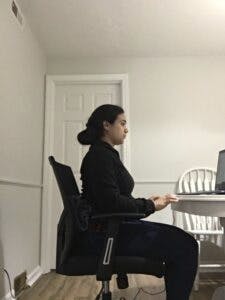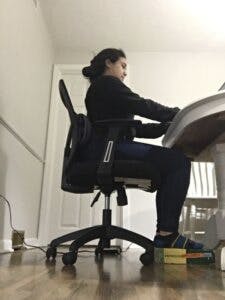Many Americans recently saw a change in their daily work routine.
With the current stay-at-home advisory extended, many of us are working, or attending
school, from home. We do not know when we will be able to go back to “normal.”
So, for now we find ourselves mostly at home, and if you are anything like me,
you are sitting for most of the day.
With the current stay-at-home advisory extended, many of us are working, or attending
school, from home. We do not know when we will be able to go back to “normal.”
So, for now we find ourselves mostly at home, and if you are anything like me,
you are sitting for most of the day.
While sitting may seem like a harmless activity, it can cause both
short-term and long-term problems. A small research study1 looked at
the effects of prolonged sitting (2 hours) on the stiffness of the spine, and
found that in university-age men, stiffness of the spine increased after only 1
hour of sitting, whereas in women it varied in the 2 hour window. The reality
is that many of us are sitting for longer than 2 hours. Chronic prolonged
sitting can be detrimental to your long-term health. In a recent study2,
researchers found that sitting for long hours (usually 6+ hours) is associated
with all-cause and cardiovascular disease mortality risk in sedentary adults,
but this association is decreased or completely undone when the recommended
levels of weekly moderate/vigorous exercise are met.
short-term and long-term problems. A small research study1 looked at
the effects of prolonged sitting (2 hours) on the stiffness of the spine, and
found that in university-age men, stiffness of the spine increased after only 1
hour of sitting, whereas in women it varied in the 2 hour window. The reality
is that many of us are sitting for longer than 2 hours. Chronic prolonged
sitting can be detrimental to your long-term health. In a recent study2,
researchers found that sitting for long hours (usually 6+ hours) is associated
with all-cause and cardiovascular disease mortality risk in sedentary adults,
but this association is decreased or completely undone when the recommended
levels of weekly moderate/vigorous exercise are met.
What does this tell us? That prolonged sitting today can cause
problems both today and tomorrow. Here are 3 tips to combat the risks
associated with prolonged sitting.
problems both today and tomorrow. Here are 3 tips to combat the risks
associated with prolonged sitting.
1: Office Ergonomics
Some basics: Sit up with your back supported, use a lumbar roll or
a towel roll along the small of your back for support. Elbows should be
approximately 90 degrees, with wrists in a neutral position. Your neck should
be held in a neutral position (ears aligned with your shoulders; shoulders set
back). Ideally, have your monitor set up to eye level.
a towel roll along the small of your back for support. Elbows should be
approximately 90 degrees, with wrists in a neutral position. Your neck should
be held in a neutral position (ears aligned with your shoulders; shoulders set
back). Ideally, have your monitor set up to eye level.
Knees should be approximately 90 degrees, and feet should rest
comfortably on the ground. Use a phone book (or your pathology book from
college) to adjust the “height” of the floor if you are short like me.
comfortably on the ground. Use a phone book (or your pathology book from
college) to adjust the “height” of the floor if you are short like me.
If you are using a laptop, try angling the laptop to help with the
eye level. This is not ideal.
eye level. This is not ideal.
2: Take Stretch Breaks
Sitting keeps the hamstrings, hip flexors, chest musculature, and neck
extensors short and tight, while it lengthens and weakens the quadriceps, neck flexors,
and upper back/shoulder blade musculature. Get out of that seated position
every 1-2 hours to stretch out and walk around the house. Some people have
standing desks. If that is you, use that to your advantage. Otherwise, stretch
the chest and squeeze your shoulders back, stretch your hamstrings and your hip
flexors, and do a lap around the house.
extensors short and tight, while it lengthens and weakens the quadriceps, neck flexors,
and upper back/shoulder blade musculature. Get out of that seated position
every 1-2 hours to stretch out and walk around the house. Some people have
standing desks. If that is you, use that to your advantage. Otherwise, stretch
the chest and squeeze your shoulders back, stretch your hamstrings and your hip
flexors, and do a lap around the house.
In our next blog post about working from home, we will go over
more specific stretches to do at home.
more specific stretches to do at home.
3: Hit the Recommended Activity Levels
Regardless of how long you sit for, regular moderate to vigorous
activity is still the best way to combat long term health issues associated
with chronic prolonged sitting.
activity is still the best way to combat long term health issues associated
with chronic prolonged sitting.
For most adults, the America College of Sports Medicine recommends
150-300 minutes of moderate-intensity aerobic activity per week, or 75-150
minutes of vigorous-intensity aerobic activity per week, and 2 or more
days per week of strength training of all major muscle groups of the body.
150-300 minutes of moderate-intensity aerobic activity per week, or 75-150
minutes of vigorous-intensity aerobic activity per week, and 2 or more
days per week of strength training of all major muscle groups of the body.
Similarly, older adults should engage in 150-300 minutes of
moderate-intensity activity, and this should include a mix of aerobic
training, strength training, and balance training. Older adults should also
take special consideration of any co-occurring conditions. Remember to always
consult with your physician or physical therapist when starting a new exercise
program.
moderate-intensity activity, and this should include a mix of aerobic
training, strength training, and balance training. Older adults should also
take special consideration of any co-occurring conditions. Remember to always
consult with your physician or physical therapist when starting a new exercise
program.
Here are some ideas of aerobic activities: walking around the
neighborhood, hiking along the beautiful trails of Cape Cod, walking on the
beach, a light jog or run outside, body-weight circuit training, bike riding, roller
blading, jumping rope, dancing/aerobic dance to name a few. If you need some
help getting started, or feel most motivated when working with others, check
out our offering of FitPlan Live VIRTUAL classes at Mashpee Fitness.
neighborhood, hiking along the beautiful trails of Cape Cod, walking on the
beach, a light jog or run outside, body-weight circuit training, bike riding, roller
blading, jumping rope, dancing/aerobic dance to name a few. If you need some
help getting started, or feel most motivated when working with others, check
out our offering of FitPlan Live VIRTUAL classes at Mashpee Fitness.
I hope you find these tips helpful. Keep an eye out for the next
blog!
blog!
Blog post by Damaris Marques
PT DPT.
PT DPT.
About Damaris
Marques PT DPT
Marques PT DPT
Damaris
(“Dee”) joined Cape Cod Rehab in August 2017 after receiving both her
Doctor of Physical Therapy and Bachelor of Science from Springfield College.
She is certified in Part I and Part II of the Burdenko Method and believes in a
patient-therapist partnership where both are working together to meet the
patient’s functional goals. Dee is bilingual (English and Brazilian Portuguese)
and lists crocheting as a hobby along with singing and a little dancing when no
one is looking!
(“Dee”) joined Cape Cod Rehab in August 2017 after receiving both her
Doctor of Physical Therapy and Bachelor of Science from Springfield College.
She is certified in Part I and Part II of the Burdenko Method and believes in a
patient-therapist partnership where both are working together to meet the
patient’s functional goals. Dee is bilingual (English and Brazilian Portuguese)
and lists crocheting as a hobby along with singing and a little dancing when no
one is looking!
References
1. Beach TA, Parkinson RJ, Stothart JP, Callaghan JP. Effects of
prolonged sitting on the passive flexion stiffness of the in vivo lumbar spine.
Spine J. 2005 Mar-Apr;5(2):145-54.
prolonged sitting on the passive flexion stiffness of the in vivo lumbar spine.
Spine J. 2005 Mar-Apr;5(2):145-54.
2. Stamatakis E, Gale J, Bauman A, Ekelund U, Hamer M, Ding D.
Sitting Time, Physical Activity, and Risk of Mortality in Adults. J Am Coll
Cardiol. 2019 Apr 30;73(16):2062-2072. doi:
10.1016/j.jacc.2019.02.031.
Sitting Time, Physical Activity, and Risk of Mortality in Adults. J Am Coll
Cardiol. 2019 Apr 30;73(16):2062-2072. doi:
10.1016/j.jacc.2019.02.031.
Resources
1. Link to American College of Sports Medicine COVID-19 Tips: https://www.acsm.org/read-research/newsroom/news-releases/news-detail/2020/03/16/staying-physically-active-during-covid-19-pandemic
2. Link to the Physical Activity Guidelines for Americans: https://health.gov/our-work/physical-activity/current-guidelines






